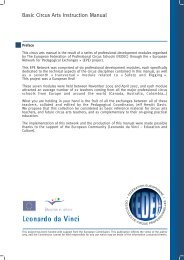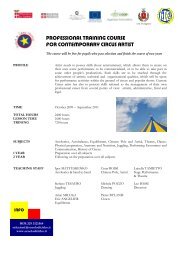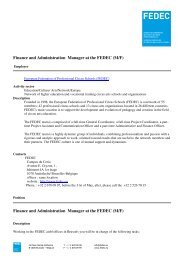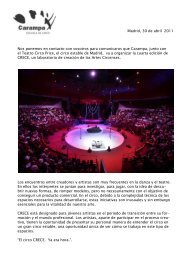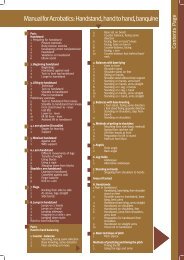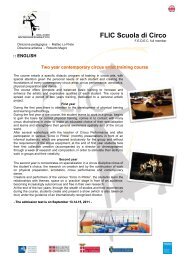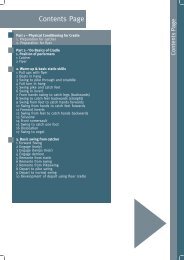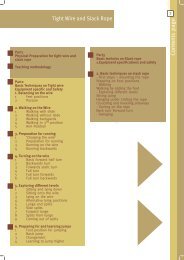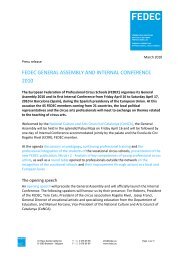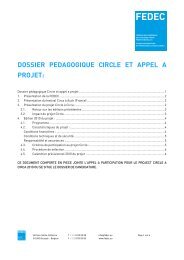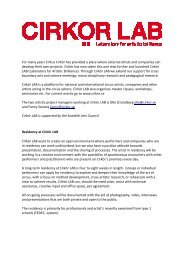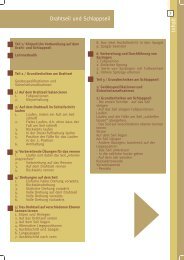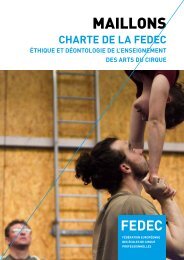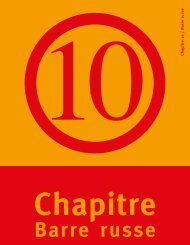InstructIon MAnuAL - Fedec
InstructIon MAnuAL - Fedec
InstructIon MAnuAL - Fedec
You also want an ePaper? Increase the reach of your titles
YUMPU automatically turns print PDFs into web optimized ePapers that Google loves.
dAnCE And MovEMEnt<br />
a movement workshop can be useful for the technical and<br />
artistic development of the circus artist, alongside teaching<br />
of how to use the cyr wheel.<br />
a complementary movement workshop can be based on<br />
one approach (for example: technical release, floor work,<br />
contact, improvisation) or on a combination of different<br />
approaches.<br />
this will improve the students’ sensitivity and awareness<br />
and will help them build their body and become more<br />
aware of it using their senses and their feelings, before,<br />
during and after the movement. this starts with searching<br />
for an anchoring to the ground by establishing bases<br />
of support (vertically, with hands and feet, horizontally<br />
with different body parts such as the back, pelvis, head,<br />
arms etc.); searching for the body centre as a result of<br />
forces exerted upon the body, a point where forces cancel<br />
each other out, an anchoring point around which the<br />
body arranges itself; releasing the body and using gravity<br />
to relieve muscular tension and working with the correct<br />
amount of energy in relation to the effort required.<br />
By adding the sense of direction the body finds its positioning<br />
within space; it draws and creates volume and<br />
generates spatial tensions that are constantly stimulating,<br />
in order to build and develop a choreographed material<br />
which can be integrated into work with a piece of<br />
apparatus. By integrating breathing, students understand<br />
the notion of suspension, impulsion, attack, new impetus,<br />
as well as heaviness and lightness.<br />
the actions of touching, rolling and sliding of different<br />
body parts (hands and feet, but also pelvis, head, back<br />
arms etc) will help students to widen their vocabulary and<br />
keep in touch with their feelings; to know how to position<br />
themselves in their performance space; to discover endless<br />
spatial orientations and different heights (high, middle,<br />
low) in order to familiarise themselves with their own<br />
sphere of movement.<br />
improvisation is a technique which helps students<br />
develop their autonomy, their artistic intelligence and<br />
kinaesthetic creativity as well as give a space and time<br />
dimension to their body and movement work. this could<br />
give a new impetus to their own personal work around<br />
their discipline.<br />
improvisation helps students to be receptive to the<br />
rhythm of movement, of phrases and sequences, to sound<br />
or silence whilst making themselves available and being<br />
exploratative. it helps them search for personalisation<br />
when faced with different options, to move in the direction<br />
of their own feelings, to work in the here and now in order<br />
to make the movement real and to clarify their intentions<br />
so that they are easier to interpret.<br />
© fedec 2011 CYR WHEEL<br />
47



